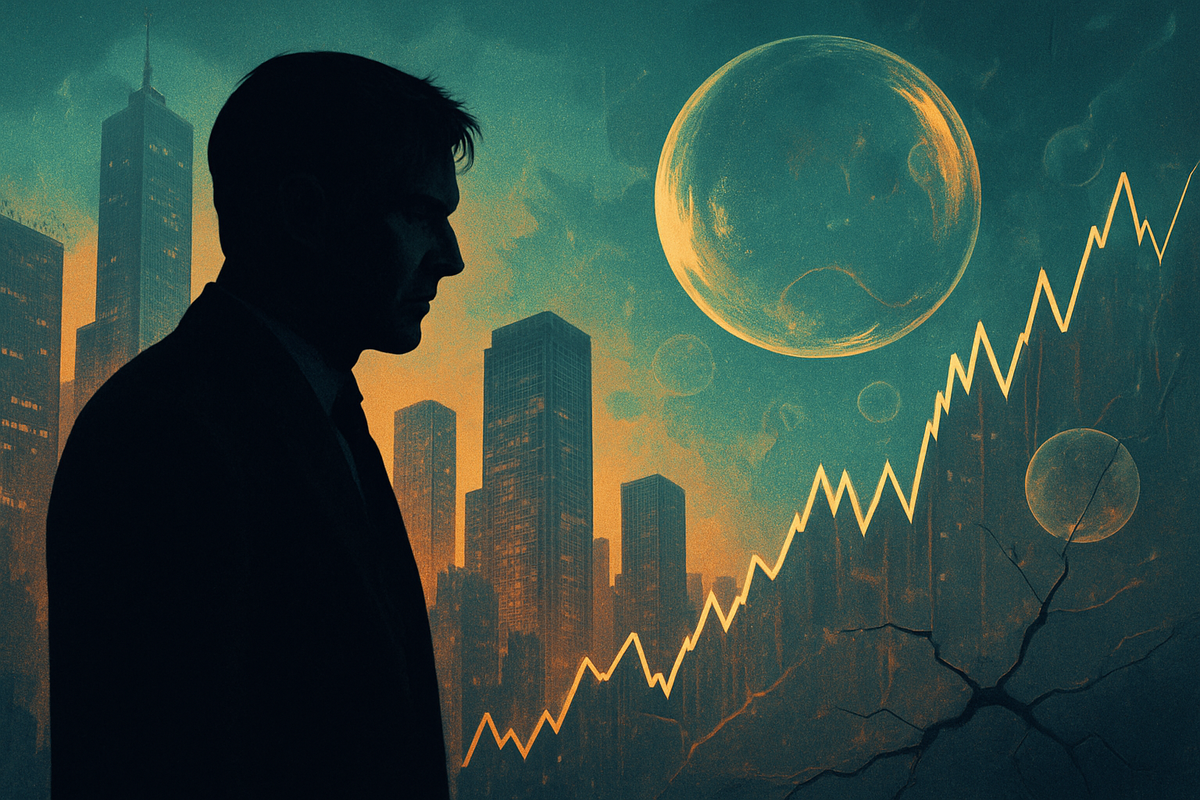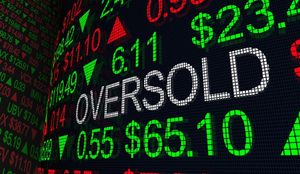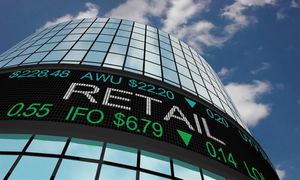
Michael Burry, the enigmatic investor famed for foreseeing the 2008 housing collapse, is once again making headlines with dire warnings about a burgeoning economic bubble and pointed criticisms aimed at Federal Reserve Chair Jerome Powell. With the calendar now reading November 2025, Burry's most recent pronouncements zero in on an "increasingly bearish thesis on artificial intelligence," suggesting that markets are "deep in bubble territory" and drawing unsettling parallels to past speculative manias. His consistent message: current Fed policies are distorting financial markets and setting the stage for a significant downturn.
Burry's warnings are not new, having begun in earnest in 2021 with his declaration of the "greatest speculative bubble of all time." However, his November 2025 newsletter, detailing his AI bubble concerns, underscores a renewed urgency in his outlook. He contends that the Fed's interventions, particularly under Chair Powell, have hindered genuine "price discovery" and fueled an environment ripe for collapse. This latest alert serves as a stark reminder for investors to scrutinize market fundamentals amidst what Burry perceives as widespread overvaluation.
Unpacking Burry's Dire Prognosis and the Fed's Role
Michael Burry's recent warnings are deeply rooted in his observation of what he terms a "massive economic bubble," with the artificial intelligence sector currently at its epicenter. In his November 2025 newsletter, Burry articulated a "bearish thesis" on AI, arguing that the market's enthusiasm for AI-related companies has driven valuations to unsustainable levels. He specifically highlights his short positions on high-flying tech firms like Nvidia (NASDAQ: NVDA) and Palantir (NYSE: PLTR), asserting that the long-term returns on AI investments will ultimately disappoint and that companies are potentially overstating the useful life of chips, thereby understating depreciation and inflating short-term profits. This echoes his earlier warnings from 2021, when he predicted the "mother of all crashes" for meme stocks and cryptocurrencies, a forecast that saw partial fulfillment in subsequent market corrections.
The timeline of Burry's increasingly vocal concerns spans several years, beginning prominently in 2021 with his broad condemnation of market speculation. His criticisms intensified through 2022 and 2023, consistently targeting the Federal Reserve's accommodative policies. Burry argues that the Fed's actions, such as maintaining low interest rates and engaging in aggressive bond-buying during the pandemic, were well-intentioned but ultimately "contributed to historic inflation" and distorted asset prices. His most pointed criticisms are directed at Jerome Powell, with Burry famously tweeting in March 2023 that Powell should "butt out" and allow markets to achieve "some real price discovery" rather than constantly intervening to prevent panic or adjust rates.
Key players in this unfolding narrative are, of course, Michael Burry, whose contrarian bets have a storied history, and Federal Reserve Chair Jerome Powell, who leads the institution Burry accuses of market manipulation. The initial market reactions to Burry's warnings are often mixed; while some investors heed his caution and adjust portfolios, others view his pronouncements as overly pessimistic or premature. However, given his track record, his recent focus on the AI sector has prompted renewed debate among analysts and investors regarding the sustainability of current tech valuations, leading to increased scrutiny of earnings reports and forward guidance from companies like Nvidia and Palantir.
Winners and Losers in a Potentially Bursting Bubble
Should Michael Burry's predictions of a massive economic bubble prove accurate, the landscape of public companies would undoubtedly see a dramatic reshuffling of winners and losers. At the forefront of potential losers would be companies operating within the sectors Burry has specifically targeted: high-flying technology firms, particularly those heavily invested in or valued on the promise of artificial intelligence. Companies like Nvidia (NASDAQ: NVDA), a dominant player in AI chips, and Palantir (NYSE: PLTR), an AI data analytics firm, which Burry has openly shorted, stand to lose significant market capitalization if their valuations are indeed inflated beyond sustainable fundamentals. Similarly, any companies categorized as "meme stocks" or those with speculative business models and high debt loads would be extremely vulnerable to a market correction, as investor sentiment shifts away from risk-taking towards safety and tangible value.
Conversely, a market downturn or bubble burst could create an environment where value-oriented companies and sectors with strong, stable fundamentals thrive. Businesses in defensive sectors such as utilities, consumer staples, and healthcare, which tend to be less sensitive to economic cycles, might see increased investor interest as capital flows out of speculative assets. Furthermore, companies with robust balance sheets, consistent free cash flow, and reasonable valuations would likely weather a downturn more effectively, potentially emerging stronger. Short-sellers, like Burry himself, who position themselves against overvalued assets, would naturally be among the direct financial beneficiaries of such a market correction.
The impact on these companies would be profound. For those at risk, a sharp decline in stock prices could lead to significant challenges in raising capital, reduced consumer confidence affecting sales, and increased pressure to cut costs or restructure. Growth prospects would be severely hampered, and some highly leveraged companies could face solvency issues. For the more resilient companies, a market correction might present opportunities to acquire distressed assets, expand market share as weaker competitors falter, or attract capital from investors seeking stability. The overall effect would be a recalibration of market expectations, forcing companies across all sectors to demonstrate genuine profitability and sustainable growth rather than relying on speculative hype.
Broader Implications and Historical Echoes
Michael Burry's warnings resonate with broader industry trends characterized by heightened speculative activity and an increasing reliance on monetary policy to prop up financial markets. His critique of the Federal Reserve's role in distorting asset prices speaks to a recurring debate about the central bank's influence on market cycles. Many economists and investors share Burry's concern that years of ultra-low interest rates and quantitative easing have created an environment where risk is mispriced, leading to asset bubbles across various classes, from real estate to equities and cryptocurrencies. The current enthusiasm surrounding artificial intelligence, while promising, exhibits characteristics reminiscent of past tech booms, fueling anxieties about a similar bust if underlying profitability doesn't materialize as quickly as valuations suggest.
The potential ripple effects of a bursting bubble, as envisioned by Burry, could be far-reaching. Beyond the immediate impact on specific companies, a significant market correction could erode consumer confidence, leading to reduced spending and a slowdown in economic growth. Financial institutions heavily exposed to overvalued assets or speculative loans might face liquidity issues, potentially triggering a broader credit crunch. Competitors and partners of highly valued tech firms could also feel the pinch, as investment dries up and expansion plans are put on hold. Regulatory bodies might face increased pressure to scrutinize market practices, particularly in nascent or rapidly expanding sectors like AI, potentially leading to new policies aimed at curbing speculation or enhancing investor protection.
Historically, Burry often draws parallels to previous bubbles, such as the dot-com bust of the late 1990s and the subprime mortgage crisis he famously predicted in the mid-2000s. He has explicitly referenced former Fed Chair Alan Greenspan's 2005 assertion that housing prices showed no signs of a bubble, just two years before the market imploded. Burry sees history "rhyming again," suggesting that policymakers are once more overlooking clear signs of speculative excess. These historical precedents serve as stark reminders of the devastating economic consequences that can follow unchecked market exuberance and highlight the challenges regulators face in identifying and addressing bubbles before they burst.
What Comes Next: Navigating the Uncertain Landscape
The immediate future, in light of Michael Burry's persistent warnings, is likely to be characterized by heightened market volatility and a prevailing sense of caution among investors. In the short term, we could see continued rotation out of highly speculative growth stocks, particularly those in the AI sector, as investors prioritize fundamental strength and valuation. This shift could lead to increased scrutiny of corporate earnings reports, with a greater emphasis on profitability rather than just revenue growth. The ongoing debate surrounding Federal Reserve policy will also remain a key driver, with every statement from Jerome Powell and other Fed officials being dissected for clues about future interest rate trajectories and monetary tightening.
Looking further ahead, the long-term possibilities range from a managed market correction—a "soft landing"—to a more severe economic downturn, a "hard crash," depending on the catalyst and the Fed's response. A significant market re-evaluation could prompt strategic pivots across industries, as companies adapt to a new era of capital scarcity and increased investor demand for tangible returns. For example, AI companies might need to accelerate their path to profitability, demonstrating clear use cases and revenue generation rather than relying on future potential. This environment could also create significant market opportunities for astute investors who have maintained liquidity and are prepared to acquire undervalued assets during a downturn, much like Burry himself profited from the 2008 crisis.
Potential scenarios and outcomes are varied. One scenario involves a gradual unwinding of speculative positions, allowing the market to slowly deflate without a catastrophic crash. Another, more pessimistic scenario, aligns with Burry's "mother of all crashes" prediction, where a trigger event—perhaps a major corporate default or an unexpected economic shock—sends markets spiraling. In either case, the market challenges that may emerge include reduced access to cheap capital, a more discerning investor base, and increased pressure on corporate balance sheets. Conversely, opportunities could arise in distressed asset investing, value investing, and for companies that can demonstrate resilience and adaptability in a challenging economic climate.
Wrap-Up: A Call for Prudence in Unsettled Times
Michael Burry's consistent and increasingly urgent warnings about a "massive economic bubble," particularly his recent focus on the artificial intelligence sector in November 2025, serve as a critical reminder for investors in what he perceives as unsettled financial times. The key takeaway from his pronouncements is the enduring risk of speculative bubbles fueled by prolonged periods of easy money and distorted market signals. His direct criticisms of Federal Reserve Chair Jerome Powell and the Fed's policies highlight a fundamental concern that interventionist measures, while intended to stabilize, may inadvertently sow the seeds of future instability by preventing natural price discovery and encouraging excessive risk-taking.
Moving forward, the market faces a period of heightened uncertainty. Investors must contend with the possibility that current valuations in certain high-growth sectors may not be sustainable in the long run. Burry's historical track record lends significant weight to his contrarian views, urging a deeper examination of corporate fundamentals and a healthy skepticism towards widespread market exuberance. His warnings underscore the importance of diversification, risk management, and a disciplined investment approach that prioritizes long-term value over short-term speculative gains.
The lasting impact of Burry's current warnings will depend on whether the market experiences the significant correction he anticipates. Regardless of the immediate outcome, his voice contributes to a vital dialogue about financial stability, the role of central banks, and the potential pitfalls of speculative fervor. Investors should closely watch for shifts in Federal Reserve rhetoric and policy, inflation data, corporate earnings reports (especially from high-growth tech companies), and overall market sentiment. These indicators will provide crucial insights into whether the market is indeed heading towards the "mother of all crashes" or if it can navigate the current landscape without succumbing to Burry's dire predictions.
This content is intended for informational purposes only and is not financial advice





